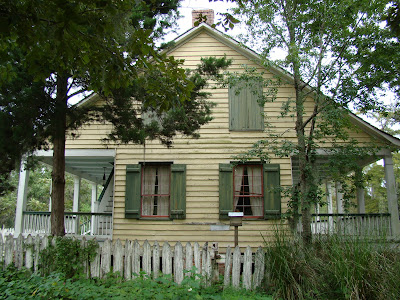
It takes 5 balls of homespun cotton yarn to make a single woven shirt. Armadillo tastes like pork. Older boys would climb a narrow outside staircase to reach attic sleeping quarters in a garconniere.

Visitors can learn this and more at the outdoor museum of Cajun and Creole heritage on the Bayou Vermilion, 2-1/2 hours drive west of New Orleans.
In the village visitors experience Acadiana culture dating from the 1760s. Spend the day wandering through the 18 historic buildings made of colombage (half-timber) and bousillage (mud and Spanish moss) in a park like setting. Once inside, meet costumed craftsmen and musicians.
There’s Daphne - quilter, basket weaver and storyteller. She sits by the open window welcoming guests, giving a glimpse of Cajun life and crafts.
 In the next house, her mother Geraldine talks about her childhood memories growing up in bayou country. Seeing hogs butchered as a little girl, or bread wrapped in a flour sack, hanging from a nail in a roof beam to keep it out-of-reach of pests and small fry. She can tell you what a raccoon or armadillo tastes like. Geraldine has traveled the world as an ambassador of Cajun culture, demonstrating doll making and other crafts.
In the next house, her mother Geraldine talks about her childhood memories growing up in bayou country. Seeing hogs butchered as a little girl, or bread wrapped in a flour sack, hanging from a nail in a roof beam to keep it out-of-reach of pests and small fry. She can tell you what a raccoon or armadillo tastes like. Geraldine has traveled the world as an ambassador of Cajun culture, demonstrating doll making and other crafts.Hungry? Stop in or make a reservation at the Creole restaurant, La Cuisine de Maman (866-99-BAYOU). After lunch you can enjoy a nature walk, or a bateau ride on the Bayou Vermilion.
The French spoken in Louisiana is very old. Acadian refugees brought it to the region from Nova Scotia in the mid-1700’s. Add a sprinkling of words borrowed from Native Americans and Africans, and voila - the Cajun dialect. At various times in the early 20th century, speaking French was forbidden by Louisiana law, and you’ll see the words “I will not speak French in school” written on the blackboard inside the one room schoolhouse.

Today the Cajuns remain bilingual and the culture is thriving. On weekends there’s zydeco music and dancing in Le Jour de Fete.
Vermilion Ville is open Tuesday through Sunday from 10 am until 3 pm. Admission is $8 for adults and $5 for students (children under 5 are free) Visit their website at www.vermilionville.org. It’s written in English and French.
Ca c’est bon!



